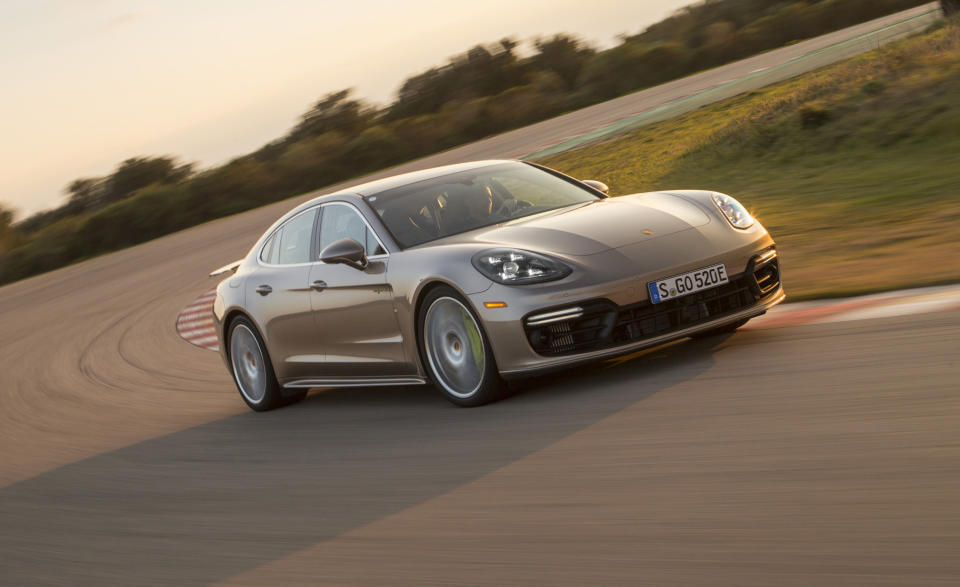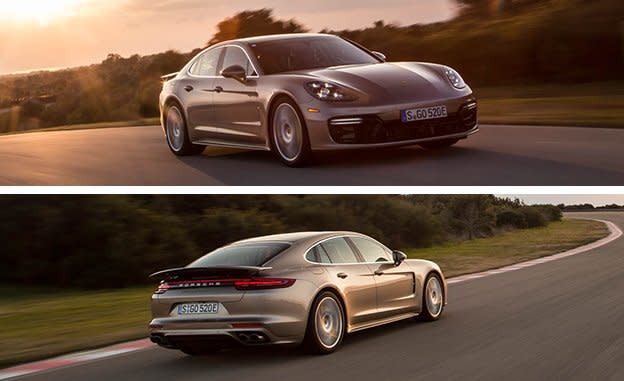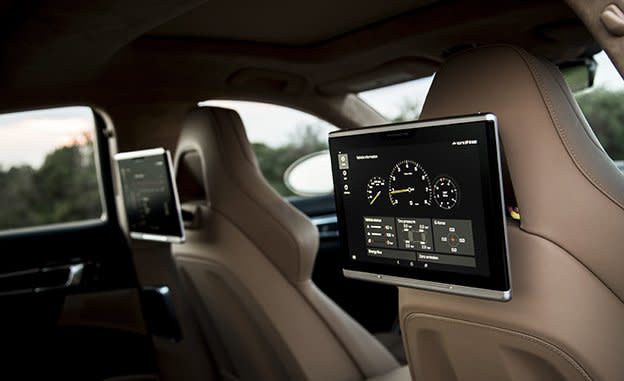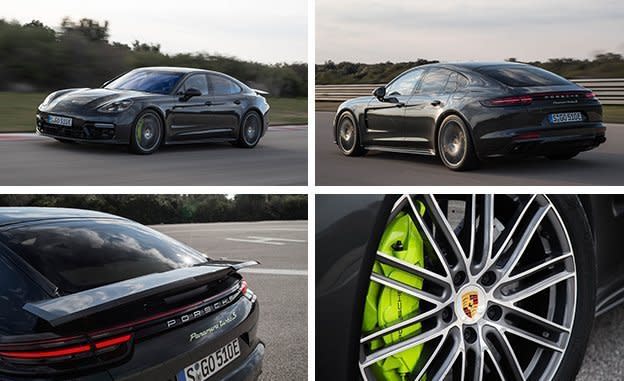2018 Porsche Panamera Turbo S E-Hybrid

To put Porsche’s new top-dog Panamera Turbo S E-Hybrid plug-in sports sedan in perspective, please leap back half a century. While building the 917 sports racer that earned Porsche its first Le Mans victories, in 1970 and 1971, development director Ferdinand Piëch ordered his engineering team to trim weight by any reasonable means. A seemingly trivial idea worth a few ounces was changing the shift knob’s material from aluminum to birch wood. In 2003, when the Carrera GT brought Porsche’s racing acumen to the street, that car’s laminated balsa-wood shift knob paid homage to the 917’s engineering discipline and competition success.
Today’s path to performance isn’t so elegant. Porsche’s “electromobility” strategy—as embodied by this Panamera Turbo S E-Hybrid, which we rode in but have not yet driven—thrusts the brand’s flagship four-door into the large-SUV weight class. The notion of a 5200-pound sports sedan at first seems in stark contrast to the Porsche ethos. A deeper examination reveals that hybridization might be able to improve all three attributes that define a modern supersedan: environmental responsibility, dynamic performance, and truly indulgent creature comforts.

Heavy Performance, Man
During rides in the Turbo S E-Hybrid with Porsche pro drivers Timo Bernhard and Lars Kern at the Nardò Test Center in southern Italy, weight was never an issue. The Panamera jinked with a prizefighter’s cunning agility to post remarkable acceleration, cornering, and braking performance stats. Launch-controlled thrust topping an indicated 1.30 g slammed every head in the cabin into the backrests, on the way to 60 mph in barely more than three seconds. (Our testing has seen lesser Panameras sprint to 60 mph as quickly as 3.3 seconds.) On Nardò’s 16-turn handling loop, the pros easily posted 1.50-plus cornering g’s without a whimper of protest from the 21-inch Michelin tires, as well as more than 1.00 g under braking. The difficulty in blending regenerative and friction braking that we observed in the Panamera 4 E-Hybrid has been resolved, says Porsche. Nudging the Panamera’s 192-mph indicated top speed required nothing more than steady hands on the wheel. The saving grace of witnessing this show of strength from the back seat is that you’re treated to a real-time view of g-forces darting across display screens attached to the front buckets’ backrests and the full fury of the V-8’s sport-exhaust serenade.
From the outside, the second-generation Panamera is a 911 Carrera kneaded into a four-seat hatchback sedan. During breaks from flat-out lapping sessions, Gernot Döllner, who has guided Porsche’s performance hybridization strategy and development since the creation of the original 918 Spyder concept, explained that the hardware and equipment within this envelope has the versatility needed to set new Porsche performance standards. For example, 30 or more miles of engine-off electric driving combined with the strongest acceleration ever seen in a Panamera.
The Mechanicals (and the Electricals)
While hybrids often are spun from conventional underpinnings, the MSB platform was conceived as a dual gasoline-and-electric architecture from the start. The Panamera Turbo S combines Porsche’s 4.0-liter, 550-hp twin-turbo V-8 with a 136-hp AC motor/generator packed inside a new ZF eight-speed dual-clutch automatic transmission-cum-transfer case. That yields a combined 670 horsepower and an awesome 626 lb-ft of torque ready and able to spin all four tires. A 14.1-kWh battery pack containing 104 liquid-cooled lithium-ion cells inside an aluminum box the size of a large suitcase lives beneath the cargo floor just ahead of the rear bumper.

None of these components are light. The crash-resistant battery pack and its mounting hardware, for example, weigh more than 300 pounds. Even though Porsche’s engineers trimmed 41 pounds from the unibody with a more extensive use of aluminum, the scales tip in the other direction with the electric motor, yards of copper wiring, additional driveline parts, and 113 electronic control units. Add to that the huge carbon-ceramic brake rotors squeezed by 28 hydraulic pistons (10 per front wheel, four per rear wheel), four-wheel steering, air springs, adjustable dampers, and adaptive anti-roll bars powered by a 48-volt electrical system. Inside are four-zone climate control, four highly adjustable bucket seats, a two-panel sunroof, and touchscreens and switches galore commanding 6000 customer functions, according to Döllner.
Compared with an all-wheel-drive, 550-hp Panamera Turbo, the top-spec E-Hybrid edition is some 700 pounds heavier and more lavishly equipped, in keeping with its $185,450 starting price. That’s $37,500 more than a non-hybrid Turbo, but a bargain of sorts if you total the incremental cost of all the gear that’s standard in this Turbo S. The shocker, though, is the nearly $100,000 spread between the 330-hp base Panamera and the Turbo S E-Hybrid. (The Executive model, with a 5.9-inch-longer wheelbase, costs $195,850.) With a total of 11 models in the Panamera family plus a comprehensive options list, there’s one for every (thick) purse and purpose.

Moving Forward
Our grasp of Porsche’s aggressive hybridization strategy won’t be complete until we add the pieces currently missing from this puzzle. While fuel consumption versus the nonhybrid Turbo dropped by an encouraging 69 percent on the European driving cycle, the mileage in our hands and during EPA testing remains unknown. We also look forward to comparing this heavy hybrid to conventional supersedans from the driver’s seat on U.S. roads. Only then will we really know exactly what has been accomplished by Porsche’s flat-out hustle down the hybrid highway.
Skeptics in the audience should pay heed to the following: The days of trimming pounds with lightweight shift knobs are gone forever. That said, Porsche Panamera boss Döllner characterizes dueling powertrains as a “bridging” technology, implying there’s something better and probably lighter on the far shore. Assuming that the Mission E pure-electric vehicle Porsche started discussing two years ago was an accurate predictor, at least some of this brand’s marvelous combustion engines will be eligible for retirement in five years. Or less.
Specifications >
VEHICLE TYPE: front-engine, front-motor, all-wheel-drive, 4-passenger, 4-door hatchback
BASE PRICE: $185,450–$195,850
ENGINE TYPE: twin-turbocharged and intercooled DOHC 32-valve 4.0-liter V-8, 550 hp, 568 lb-ft; permanent-magnet synchronous AC electric motor, 136 hp, 295 lb-ft; combined output, 670 hp, 626 lb-ft; 14.1-kWh lithium-ion battery pack
TRANSMISSION: 8-speed dual-clutch automatic with manual shifting mode
DIMENSIONS:
Wheelbase: 116.1–122.0 in
Length: 198.8–204.7 in
Width: 76.3 in Height: 56.0–56.2 in
Passenger volume: 96–102 cu ft
Cargo volume: 14 cu ft
Curb weight (C/D est): 5200–5400 lb
PERFORMANCE (C/D EST):
Zero to 60 mph: 3.2–3.3 sec
Zero to 100 mph: 7.9–8.0 sec
Standing ¼-mile: 11.5–11.6 sec
Top speed: 192 mph
FUEL ECONOMY (C/D EST):
EPA combined: 25 mpg (battery depleted)
EPA combined: 55 MPGe (battery charged)

 Yahoo Autos
Yahoo Autos 